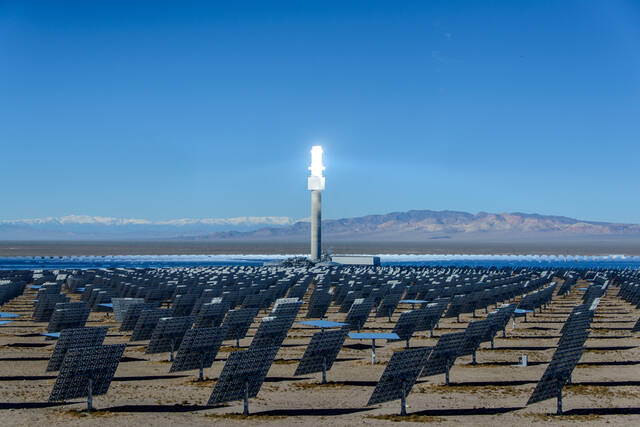COMMENTARY: Increasing blackouts underscore global power crisis
Environmentalists, along with some politicians and their allies, argue that fossil fuel and nuclear power are being irreversibly replaced by wind and solar power. They refuse to acknowledge that mining, cropland and habitat destruction, toxic wastes and other adverse effects make these electricity sources anything but clean, renewable or sustainable — or that wind and sunshine cannot provide raw materials for 6,000-plus essential products that come from petrochemicals: paints, plastics, pharmaceuticals, cosmetics, clothing and much more.
Their claim that wind and solar power are cheaper than coal, gas or nuclear power ignores that these electricity generators are weather-dependent and intermittent — and must be backed up by coal, gas and nuclear power, or by massive fire-prone battery installations.
Those multibillion-dollar backup generators double or triple electricity costs, helping explain why British and German families pay three times what typical American families do.
Despite enormous subsidies, wind and solar companies and installations frequently fail. Sunnova Energy is the latest solar company to file for bankruptcy. California’s Ivanpah solar plant on the Nevada border is also going belly-up. Ivanpah’s $2.2 billion “concentrated solar thermal power plant” uses 347,000 75-square-foot mirrors on 3,500 acres to generate electricity when the sun shines. The state’s Diablo Canyon nuclear power plant generates 20 times more electricity 24/7/365 from one-fifth the acreage.
Power outages are an equally serious problem.
A basic energy rule states that the more a state or country relies on unreliable wind and solar power, the more often it will experience blackouts. A corollary: The more voters elect politicians who focus on rare fish and climate cataclysms, the more they will be affected by blackouts.
On April 16, Spain briefly generated 100 percent of its electricity from wind, solar and hydropower. Twelve days later, a massive blackout sent Spain, Portugal and parts of France and Belgium into chaos. Airports canceled flights; lights, computers, televisions, refrigerators, cell phones, traffic lights, trains, subways and elevators stopped working.
All it took was a sudden midday loss of 60 percent of Spain’s electricity needs caused by problems in large solar installations. It triggered “a cascading failure across the entire grid.” Other generating units automatically shut down for safety or to protect the grid and other infrastructure. If nuclear-powered France hadn’t closed its connection to Spain, most of Europe could have shut down.
A week later, another blackout hit Spain’s Canary Islands.
In the United States, a sudden power outage disrupted Memorial Day weekend celebrations for families across southeastern Louisiana as power demand surged during the hottest part of the day. The blackout resulted from a “load shed” order from the regional grid reliability authority, which told utility companies to cut off electricity to customers “to prevent a more extensive, prolonged power outage that could severely affect the reliability of the power grid.”
As the corollary rule suggests, the load shed was needed — and will probably be necessary many times — because Pelican State politicians pay more attention to fashionable issues than to vital, life-or-death matters.
They provide subsidies, loan guarantees, tax breaks and fast-track permits for wind, solar and battery installations, while shutting down reliable power plants and refusing to build additional ones.
Meanwhile, they force families and businesses to convert vehicles, heating systems, stoves, water heaters and lawnmowers from gasoline and natural gas to electricity. They drive up demand while reducing electricity generation and reliability, especially during peak demand periods driven by extreme heat and cold.
Repeated, prolonged and rolling blackouts are the inevitable result.
This is happening nationwide, particularly in states with the most wind and solar electricity. California leads all states in generating solar electricity and is also a significant producer of wind energy. Texas is by far the top wind electricity generator and a major solar electricity producer. Florida is No. 3 for solar but generates no wind power.
In 2022, California also accounted for 24 percent of all U.S. power outages, Texas for 14 percent. Over the past 20 years, Florida has had the most people per capita affected by power outages, primarily because of hurricanes, but lags well behind California, Texas, New York and Michigan in the number of blackouts.
New York’s obsession with climate change has left it open to a self-inflicted blackout disaster. The fundamental problems? Insufficient surplus (margin-of-safety) generation to account for equipment failures, human errors and rising electricity demand for data centers, artificial intelligence and mandated conversions to electricity, plus aging grid infrastructure that cannot cope with sudden surges and plunges in generation by large wind and solar installations and rooftop photovoltaic solar feeding into the grid.
Hacking and terrorism also pose major dangers. One attack on a strategically chosen power plant or transformer could shut down an entire region. And America’s heavy reliance on China for wind turbines and transformers, with backdoor entry ports for “maintenance” and “software updates,” makes the country vulnerable to blackouts lasting days, weeks or months.
Politicians and voters need to get a grip on the grid and on other critical quality-of-life issues and stop obsessing over fashionable, politicized mini-matters.
Craig Rucker is president of the Committee for a Constructive Tomorrow. He wrote this for InsideSources.com.

















